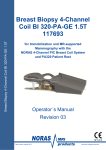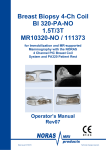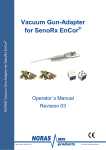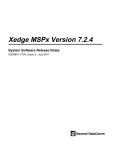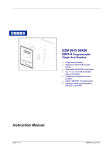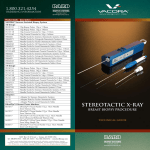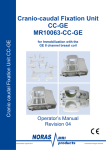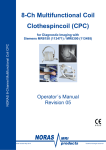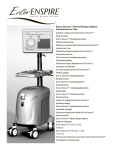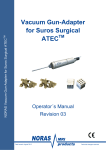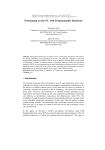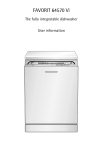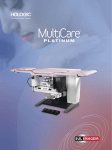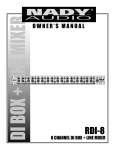Download Manual BI 320-PA-PH - Noras MRI products
Transcript
Breast Biopsy Patient Rest BI320-PA-PH Breast Biopsy Patient Rest BI320-PA-PH for Immobilization and MR-supported Mammography with the NORAS Patient Rests MR10320-PH MR10320-PH-2 Operator´s Manual Revision 08 Date issued: August 2015 Technical changes reserved. Breast Biopsy Patient Rest BI320-PA-PH 2 Content Content 1 General Information ..................................................................................... 5 2 Intended Use / Indication for Use ............................................................... 7 2.1 Indications .......................................................................................................8 2.2 Contraindication ..............................................................................................8 3 Function ........................................................................................................ 9 3.1 Safety Concept ...............................................................................................9 4 Device Description..................................................................................... 10 4.1 4.1.1 Definitions and Symbols ............................................................................... 10 Rating Plates................................................................................................ 12 4.2 4.2.1 4.2.2 4.2.3 4.2.4 System Components..................................................................................... 13 Patient Rests................................................................................................ 13 NORAS Biopsy Kit Modular ......................................................................... 14 Accessory: Cranio-caudal Fixation Unit for Breast Biopsy Patient Rest BI320-PA-PH Artikel Nr. 111905 .............................................................. 20 Combination with other Devices................................................................... 23 5 Start Up ....................................................................................................... 25 5.1 General Information ...................................................................................... 25 5.2 Coil Assembly ............................................................................................... 27 5.3 5.3.1 Positioning of the Patient Rest ......................................................................28 Head First .................................................................................................... 28 5.4 5.4.1 5.4.2 5.4.3 5.4.4 Marker Filling Instructions ............................................................................. 29 Opening Markers ......................................................................................... 29 Filling Markers.............................................................................................. 30 Closing Markers ........................................................................................... 30 Emptying Markers ........................................................................................ 31 6 Localization and Biopsy Process ............................................................. 32 6.1 6.1.1 6.1.2 With Post & Pillar Biopsy System.................................................................. 33 Post & Pillar Adapter for Ethicon Mammotome® MR ................................... 63 Application of the Post & Pillar Adapter for Ethicon Mammotome® MR in combination with the Siemens – Syngo – Biopsy Software ......................... 67 Post & Pillar Adapter for SenoRx EnCor® ................................................... 70 Post & Pillar Adapter for Suros ATECTM ...................................................... 70 Post & Pillar Adapter for Bard Vacora® ....................................................... 70 Multi-Purpose Needle Hub Assembly .......................................................... 71 6.1.3 6.1.4 6.1.5 6.1.6 Breast Biopsy Patient Rest BI320-PA-PH 3 Content 6.2 6.2.1 6.2.2 6.2.3 6.2.4 With Grid Biopsy System ..............................................................................72 Grid Needle Block Adapter for Ethicon Mammotome® MR ......................... 81 Grid Needle Block Adapter for SenoRx EnCor® .......................................... 81 Grid Needle Block Adapter for Suros ATECTM ............................................. 81 Grid Needle Block Adapter for Bard Vacora® .............................................. 82 6.3 MR-Mammography .......................................................................................82 6.4 Safety Information ......................................................................................... 84 7 Cleaning, Disinfection and Sterilization ................................................... 85 8 Maintenance, Storage and Waste Disposal ............................................. 95 8.1 Maintenance ................................................................................................. 95 8.2 Storage ......................................................................................................... 95 8.3 Waste Disposal ............................................................................................. 96 9 Technical Specification ............................................................................. 97 9.1 Historical Device Data ................................................................................... 97 9.2 Performance Data ......................................................................................... 98 9.3 Parts List ....................................................................................................... 99 9.4 9.4.1 9.4.2 9.4.3 9.4.4 9.4.5 Options and Accessories ............................................................................ 100 Compilation of the Biopsy System ............................................................. 100 Accessories for Post & Pillar Biopsy System ............................................. 100 Accessories for Grid Biopsy System .......................................................... 102 NORAS Adapter for Vacuum Guns ............................................................ 104 General ...................................................................................................... 105 10 Important Addresses ............................................................................... 106 11 Operator Training Outline ....................................................................... 107 Breast Biopsy Patient Rest BI320-PA-PH 4 General Information 1 General Information A prerequisite for safe and trouble-free operation is the proper observance of instructions, in particular the following points. The diagnostic imaging is enabled by Philips 4-Channel SENSETM Body Coil that can be integrated with foam wedges into the patient support. For biopsy, the Philips Circular Coil C1 can be used with the biopsy system and in connection with the body coil in MRI and the Patient Rest MR10320-PH-2 with the Immobilization and Biopsy System. The Philips patient rest is designed for a permissible maximum patient weight of up to 135 kg. The Philips patient rest meets the requirements of the DIN EN ISO 606012-46. Maximum allowed patient weight The maximum permissible patient weight may not be exceeded of 135 kg. G22 To receive information about new developments or accessories for your Patient Rest with Immobilization and Biopsy System, please send an e-mail with the serial number of your patient rest to [email protected] or go to www.noras.de. Before examination with patients, it is recommended to train on the phantom in order to be familiar with the system. The application conditions have a major impact on product life. Since these conditions can vary greatly from user to user, an estimate of life time is not possible. The most important factors in influencing product life are the frequency of application and processing method (cleaning, disinfection and sterilization). Breast Biopsy Patient Rest BI320-PA-PH 5 General Information Process Method: The treatment process can lead to a discoloration of the materials, but this has no influence on the material properties and product life. Mechanical Wear: Mechanical wear is dependent on the frequency of application and for the above mentioned reasons, it cannot be assessed quantitatively. Safety: Take into account the intended use and specified warnings in the manual, as well as performing of visual inspection for all components before using the product on the patient. Notice Please follow the safety instructions of MRI manufacturer for operators, patients and third parties. Prescription use only Country specific laws restrict this device to sale by or on the order of a physician, or with the descriptive designation of any other practitioner licensed by the law of the country in which he practices to use or order the use of the device. G07 This device may only be distributed to persons who are licensed practitioners or to persons who have a prescription or other order from a licensed practitioner to purchase it. Breast Biopsy Patient Rest BI320-PA-PH 6 Intended Use / Indication for Use 2 Intended Use / Indication for Use The intended use of the Breast Biopsy Patient Rest BI320-PA-PH is, in conjunction with a Magnetic Resonance Scanner, the MR examination of the female breast It is indicated for use (in combination with the Philips coils) as a diagnostic imaging device to produce transverse, sagittal, coronal and oblique images of the internal structures of the female breast. When interpreted by a trained physician, these images provide information that can be useful in determining diagnosis. The Biopsy Unit permits MR guided breast biopsy and wire localization of lesions can be performed by a trained physician. Pad Cushion112317 Head Rest Breast 112300 Patient Rest MR10320-PH-2 Philips 4-Channel SENSE™ Body Coil Biopsy Unit Breast Biopsy Patient Rest BI320-PA-PH 7 Intended Use / Indication for Use 2.1 Indications • Tumor recognition in the case of unclear diagnoses from other diagnostic procedures using contrast agents and their decay times. • Breast biopsy, i.e. biopsy from lateral, medial and cranio-caudal direction. 2.2 Contraindication All patient examinations are contraindicated with this system which is also contraindicated in the proximity of the MRI device according to the information provided by the manufacturer. Furthermore, the responsibility lies with the examination physician in case of unclear or critical clinical picture. Notice Please follow the safety instructions of MRI manufacturer for operators, patients and third parties. Breast Biopsy Patient Rest BI320-PA-PH 8 Function 3 Function The Breast Biopsy Patient Rest BI320-PA-PH consists of a Patient Rest with Immobilization and Biopsy System. Imaging is performed either with a 4-Channel SENSE™ Body Coil for diagnostic or with Philips Circular C1 Coil in combination with the Body Coil for biopsies. Thanks to the slightly tilted design of the patient rest, generous cranio-caudal access space is available for breast biopsies. Additional access space is gained in the rear area for improved operator’s manual access by the user. The Immobilization Device can be rotated by 360°. This ensures optimum access to the lesion (ca. 270°). For guidance, a telescopic assembly, the Post & Pillar System, provides access also to regions very close to the chest wall (Axilla). An additional access possibility is offered by the alternative use of the compression plates and needle blocks. Biopsy access is single-sided medial, single-sided/double-sided lateral or single-sided/double-sided cranio-caudal. 3.1 Safety Concept The following safety concept must be strictly followed while performing a biopsy: A control scan must be made after each work step to verify the correct completion of the previous work steps to be able to recognize incorrect adjustments of the needle guides bases and needle blocks during the biopsy. That is the only way to recognize incorrect adjustments, incorrectly read scale values and other operator errors in order to prevent injuries to the patient. The control scan procedure is described in Chapter 6 “Localization and Biopsy Process“ and the correct result illustrated in the text. Breast Biopsy Patient Rest Version 2 MR10320-PH-2 for Philips Breast Biopsy Patient Rest BI320-PA-PH 9 Device Description 4 Device Description 4.1 Definitions and Symbols The following symbols are used on the Breast Biopsy Patient Rest BI320-PA-PH and in this operator´s manual: ISO 7000-2497 Date of Manufacture DIN EN 980 (5.12) Manufacturer EN ISO 7000-1641 Operator´s Manual ISO 7000-0434B Caution, read the accompanying documents Directive 2002/96/EC Waste products should not be disposed of with household waste e. g. at a local authority collection point ISO 780 DIN 55402 This way up ISO 7000-0621 Fragile, handle with care ISO 7000-0626 Store in a dry place ISO 7000-0632 Temperature Limit ISO 7000-2498 Serial Number DIN EN 980 (5.10) Item Number Breast Biopsy Patient Rest BI320-PA-PH 10 Device Description Conforms to the essential requirements of Council Directive 93/42/EEC of 14 June1993 concerning medical devices. Warning regarding risks that may result in minor physical injury or material damage. Warning regarding risks that may result in death or serious physical injury. Information regarding the optimal use of the product. On the following page we describe where you can find our various rating plates on your product. In addition to the above described symbols, you will also find the model, product and serial number on these plates. Breast Biopsy Patient Rest BI320-PA-PH 11 Device Description 4.1.1 Rating Plates Base Plate The rating plate is located on the underside. Grid Biopsy Unit: lateral, medial, cranio-caudal The rating plate is located on the upper right. Post & Pillar Positioning Unit The rating plate is located on the telescopic square outside. Patientenauflage The rating plate is located on the underside. Breast Biopsy Patient Rest BI320-PA-PH 12 Device Description 4.2 System Components 4.2.1 Patient Rests 4.2.1.1 MR10320-PH The patient rest is made of 100% fiberglass. The surface has been finished with a biocompatible two-component coating Alexit. 4.2.1.2 MR10320-PH-2 The patient rest consists of two parts, an upper part and a lower part. The upper part, whose surface is made of fiberglass which will be provided with a two-component coating, the lower part is made of Seaproof. Skin contact During the examination some parts of the breast may come into contact with the surface of the base plate with the low probability. G01 Before each examination of the patients, the base plate must be covered with a clinical cloth. Breast Biopsy Patient Rest BI320-PA-PH 13 Device Description 4.2.1.3 Cushions 4.2.2 Pad Cushion Wedge Pillow Noras Head Rest Breast 112317 118310 112300 NORAS Biopsy Kit Modular Throughout our modular system, you can assemble your biopsy units according to your preferences. a) What is your preferred Biopsy Method? Post & Pillar (with Post & Pillar Biopsy System: lateral, medial, cranio-caudal) Higher accuracy compared to grid biopsy. Angulation is possible. With our Post & Pillar System (lateral, medial, cc) you can perform exact biopsies. The needle sleeve is adjustable by 15° or 30° towards posterior or anterior. Biopsies can be performed using either reusable (autoclavable) or disposable (sterile) Post & Pillar needle guide sleeves. Various height-adjustable horizontal and vertical slat plates can be used to fixate the breast. Breast Biopsy Patient Rest BI320-PA-PH 14 Device Description Grid Method (with Grid Biopsy System: lateral, medial, cc) Perform several biopsies or wire placements at various lesions in one step. The Grid Biopsy System (lateral, medial, cc) like all grid solutions, allows multiple biopsy access points within a single procedure. It is possible to perform biopsies from all sides. The unit can rotate 360° in 15° increments. Please note that this rotation radius does not apply if the Siemens Syngo® software is in use! Grid needle blocks can be freely positioned in the grid to ensure needle guidance. The cubes are available as reusable (autoclavable) or disposable (sterile) accessories. Breast Biopsy Patient Rest BI320-PA-PH 15 Device Description Grid Method (with Grid Biopsy System Height Adjustable: lateral) Perform several biopsies or wire placements at various lesions in one step. The Grid Biopsy System Height Adjustable (lateral) guarantees ideal lateral access. In particular, areas close to the thorax can be well targeted with this grid solution. A grid needle block set, consisting of 18G, 14G and 12G tubes, is available as reusable (autoclavable) or disposable (sterile) version. The fixation of the breast is done through the grid on the lateral side and horizontal or vertical slat plates on the medial side. Breast Biopsy Patient Rest BI320-PA-PH 16 Device Description Grid Method (with Grid Biopsy System Height Adjustable: lateral, medial, cc, disposable) Perform several biopsies or wire placements at various lesions in one step. The two Grid Biopsy Units Height Adjustable (lateral, medial, cc; disposable) offer a cost effective alternative for a lateral, medial and cranio-caudal breast biopsy application. The low priced disposable grids reduce autoclavable costs and improves patient throughput. The height-adjustable design guarantees best access. Biopsies and wire placements can be performed by either reusable (autoclavable) or disposable (sterile) grid needle blocks. Warning Before use, the sterile disposable grids must not come into contact with unsterile or contaminated components. Warning Before using the sterile disposable grid the instructions for use must read in full and with care. The sterile packaging and the instruments must be checked for proper condition Breast Biopsy Patient Rest BI320-PA-PH 17 Device Description Warning The sterile disposable grid is for single use only; it is not resterilizable and must be properly disposed after use. Note Only qualified personal should use sterile disposable grid. Note Please always wear protective gloves and carefully comply with the application times for Hepatitis B and HI viruses. (See the instructions for use of the respective disinfectant solution). b) Modular NORAS Biopsy Units Compatible with all NORAS 4-Channel Breast Coils and NORAS Patient Rests BI320-PA. Usable for immobilization and MR guided biopsy. Our biopsy system consists of superior plastics (PEEK) and can be used for all traditional sterilization processes (autoclavable). One has the option to purchase disposable grids for medial, lateral and cranio-caudal use for the height-adjustable gridunits. The functional unit can be build cost effectively and can be extended based upon request. Breast Biopsy Patient Rest BI320-PA-PH 18 Device Description Application Examples Modular set-up. To fixate the breast, several of height-adjustable horizontal and vertical slat plates can be used as well as a medical disposable grid or the reusable grid. To perform biopsies, one can choose from the Post & Pillar or Grid Method. Post & Pillar Biopsy System lateral with one lateral horizontal slat plate and one medial horizontal slat plate to fixate the breast. Post & Pillar Biopsy System medial or cranio-caudal with two medial horizontal slat plates to fixate the breast. Grid Biopsy System lateral with height-adjustable lateral grid and medial horizontal slat plate to fixate the breast. Grid Biopsy System lateral, medial or cranio-caudal with grid and medial horizontal slat plate to fixate the breast. Grid Biopsy System lateral with disposable lateral grid and medial horizontal slat plate to fixate the breast. Breast Biopsy Patient Rest BI320-PA-PH 19 Device Description 4.2.3 Accessory: Cranio-caudal Fixation Unit for Breast Biopsy Patient Rest BI320-PA-PH Ref. 111905 The Philips Patient Rest MR10320-PH-2 is used for diagnostic imaging and biopsy of the breast. Use for diagnostic imaging the original Philips 4-Channel SENSETM Body Coil. 4.2.3.1 Cranio-caudal Fixation Unit In order to perform a faster examination, we offer our CC-Fixation. In case of a larger chest the field of view can be reduced by half due to reducing of the scan time up to 50%. In addition, distracting movements and vibrations of the breast can be avoided. Breast Biopsy Patient Rest BI320-PA-PH 20 Device Description 4.2.3.2 Mounting of the Cranio-caudal Fixation Unit in the Patient Rest One half of the 4-Channel SENSETM Body Coil is inserted in the CC-Fixation Unit from below. By folding the movable support you can facilitate the insertion and you can bring the coil in the correct position (see picture). The upper part is then placed from above. Now the CC-Fixation Unit is sandwiched between the two coils of the 4-Channel SENSETM Body Coil. The whole system is pushed into the Patient Rest MR10320-PH-2 laterally. The upper part of the original Philips 4-Channel SENSETM Body Coil is connected to the underside of the Patient Rest using the existing Velcro straps at the coil. (For chest with chest wall obvious lesions you can heighten the coil upper part using Philips foam aids and press it to the body). Breast Biopsy Patient Rest BI320-PA-PH 21 Device Description Pull back the four guide rods (arrows A in the diagram) and place the four pressure plates (arrows C in the figure) by gently pressing on ("click"). Check whether the bolts and the intended openings are clashed. C A C A While setting of the pressure plates (arrows C in the figure) make sure that the high side of the slope directs to outside (lateral) and the deepening of the slope directs to inside (medial), so that the plates may be presented in V-shaped to the patient and in the center shows no heightening. 4.2.3.3 Handling of the Cranio-caudal Fixation Unit Fix the breast using two guide rods (arrows A in the figure). Firstly push the pressure plate toward the chest and press it lightly by a rod (arrow C in the figure) then fix the plate using the screw (arrow B in the figure). The screw can be screwed in from the side or from above). Slide the second rod slide together with pressure plate toward the chest until the desired setting is reached. Now fix it using the second screw (arrow B in the figure). Breast Biopsy Patient Rest BI320-PA-PH 22 Device Description 4.2.3.4 After mounting the Cranio-caudal Fixation Unit After fixing both breasts, drive the table to light visor and align the laser sight on the center of the coil. After retracting the patient the examination can be begun. 4.2.4 Combination with other Devices The diagnostic imaging is enabled by Philips 4-Channel SENSETM Body Coil that can be integrated with foam wedges into the patient support. For biopsy, the Philips Circular Coil C1 can be used with the biopsy system and in connection with the body coil in MRI and the Patient Rest MR10320-PH-2 with the Immobilization and Biopsy System. Special NORAS adapters are available for the use with Bard Vacora®, Suros ATEC™ and SenoRx EnCor® biopsy systems. The respective adapters for the grid system must simply be inserted in the desired position of the grid. Be sure that the adapters are firmly seated. With the help of the MRI software you can determine the correct gauge hole through which the needle must be guided. The Post & Pillar adapters are attached to the guide base and can thus serve as a needle guide. The adapters are indicated in Chapter 9.4 “Options and Accessories“. Breast Biopsy Patient Rest BI320-PA-PH 23 Device Description The Mammotome® MR Biopsy System from Ethicon, Endo-Surgery Inc. (FDA: K042753) can be used with a special adaptor. For more information see Chapter 6 “Localization and Biopsy Process“. Upon request, suitable adapters for your system can be manufactured. Combination with other devices G24 The Breast Biopsy Patient Rest BI320-PA-PH may only be used in combination with the above-named devices and coil as well as accessories supplied by NORAS MRI products GmbH. The use of accessories supplied by other manufacturers is only permitted with the express written approval of NORAS MRI products GmbH. Bodily injuries due to accessories Please follow the instructions of the accessory manufacturer. In case of biopsy needles note in particular the authorization of the field strength of the used MRI and the correlation of needle diameter and needle guide/needle block and an adequate needle length for the planned biopsy (see also Chapter 6). Noncompliance with theses instructions may lead to bodily injuries of the user or patient. Bodily injuries due to accessories When using accessories please always observe the manufacturer's instructions. Breast Biopsy Patient Rest BI320-PA-PH 24 Start Up 5 Start Up 5.1 General Information Device damage / coil error Only trained personnel may be assigned to handle the Breast Biopsy Patient Rest BI320-PA-PH. G12/G18 Operating errors may cause permanent damages to the device/coil. Bodily injuries Only trained personnel may be assigned to handle the Breast Biopsy Patient Rest BI320-PA-PH. Operating errors may cause bodily injuries (e.g. contusions) to the user and/or patient. Danger of infection Prior to start-up of the devices or parts thereof, all components must be treated as described in chapter 7 “Cleaning, Disinfection and Sterilization“. Non-compliance with the above instructions may lead to infection of the patient. Permanent damage to the system The user has to be trained prior to start-up of the device. G13 Breast Biopsy Patient Rest BI320-PA-PH 25 Start Up Bodily injuries The user bears the responsibility for using other medical devices. G15 Notice Please be sure to pay attention to and comply with the safety information and instructions of the MRI device manufacturer for operators, patients and third parties. The operator´s manual must be read by each operator prior to using this device. In order to become skilled in the proper handling of this system you should, in addition to participating in training with the system, use a phantom to become familiar with its use. Bodily injury of the patient Prior to each patient examination, you should make a careful visual inspection of the system components. G11 In case of unusual findings and/or damage found the system must not be used. Damaged parts can be sharped-edged and cause injuries to the patient and/or to the user. Assemble the desired configuration of the biopsy device. While pushing it onto the fixation plate, be sure the positioning system is pushed on as far as it will go. You can check this by listening for an audible click. Insert the biopsy device into the insertion opening provided. Ensure that the device is firmly seated. Only use sterilized needle guides or needle blocks. Breast Biopsy Patient Rest BI320-PA-PH 26 Start Up 5.2 Coil Assembly Assemble your Philips coil as presented in the pictures below, depending on whether it is for diagnostic or for biopsy. Diagnosis Biopsy Similar to the illustration Breast Biopsy Patient Rest BI320-PA-PH 27 Start Up 5.3 Positioning of the Patient Rest 5.3.1 Head First Position the system on the MRI table and plug-in the coil plug as shown in the illustration on the left. Plug Position the system at the desired location and place the wedge cushion on the MRI table in such a way that the cable lie in the cable guide of the cushion. Breast Biopsy Patient Rest BI320-PA-PH 28 Start Up 5.4 Marker Filling Instructions The product is delivered with unfilled markers. The number of markers required depends upon the individual type of system used (One marker is needed for manual localization; up to four markers are needed for software supported localization). Please pay attention to the following marker refilling instructions: 5.4.1 Opening Markers Open the Post & Pillar Marker, the Grid Marker Block or the Bolt Marker by hand. To open the marker cover in the grid use a screwdriver with a blade width of 8.6 mm and to open the cover of the cartridge marker use a screwdriver with a blade width of 5.6 mm. The cartridge marker can be released either with a screwdriver or with a needle sleeve of the unit. Be sure to use only MR compatible screwdrivers. If no MR compatible screwdrivers are available, you must fill the oil marker outside of the MR room! Post & Pillar Marker and Grid Markerblock Breast Biopsy Patient Rest BI320-PA-PH Marker Bolt Marker with Grid Cartridge Marker 29 Start Up 5.4.2 Filling Markers The markers must be filled with diluted MRI contrast agent to make them visible in the MRI. To do so, fill a syringe with contrast agent (diluted 1:200) and then slowly fill the marker with the syringe up to the edge of the marker thread starting at the bottom of the marker. Rotate the syringe during filling to prevent the formation of bubbles. Grid Markerblock 5.4.3 Marker Bolt Marker inside the Grid Cartridge Marker r Closing Markers You can close the Post & Pillar Marker, the Grid Marker Block or the Bolt Marker by hand. Post & Pillar Marker Grid Markerblock To close the marker cover in the grid use a screwdriver with a blade width of 8.6 mm and to close the cover of the cartridge marker use a screwdriver with a blade width of 5.6 mm. Be sure to use only MR compatible screwdrivers. If no MR compatible screwdrivers are available, you must fill the oil marker outside of the MR room! Breast Biopsy Patient Rest BI320-PA-PH 30 Start Up Test Measurement Test marker imaging by installing the biopsy system and taking a test measurement. The markers must be homogeneously imaged. They must not exhibit any “holes” which are air bubbles (which can also be recognized as a “kink” in the marker). If the marker cannot be imaged as a straight line, then change the phase code direction during imaging and verify the changed settings. 5.4.4 Emptying Markers Markers must be emptied prior to sterilization! To empty them, open the markers as described above and empty them (Caution! Marker liquid is harmful, see warning instruction). Use a syringe (filled with distilled water) to rinse out the markers starting at the bottom of the marker to remove any residual marker liquid. Then dry them or open and place them in upright position within in the steam autoclave. Health hazard for operator Marker liquid is harmful! Please note the warnings! Breast Biopsy Patient Rest BI320-PA-PH 31 Localization and Biopsy Process 6 Localization and Biopsy Process The biopsy procedure is based upon the safety concept described in chapter 3 “Function “.Compliance with this concept is mandatory. Permanent damage to the system The fixation screws should be removed from the basic unit fixation plate during medial application. In case of a higher load on the patient rest a damage of the screws could not be excluded. When using the grid as a medial application the fixation screws must not be mounted. The screws are only necessary as additional fixation of the grid for the lateral application. The medial grid is always mounted in the lowest possible position. It is sufficiently fixated with the ball catch. The fixation screws are part of the standard delivery of the basic unit fixation plate. The basic unit fixation plate can be used both lateral and medial. Using the grid in lateral position it can be moved in 10mm steps up to max. 30 mm in posterior direction. Only with this application, the screws are necessary for a safe fixation. Breast Biopsy Patient Rest BI320-PA-PH 32 Localization and Biopsy Process 6.1 With Post & Pillar Biopsy System Permanent damage to the system The system may only be assembled by trained medical personnel. Incorrect assembly and operator errors made by untrained personnel can permanently damage individual parts of optional components and of the device itself. Training of personnel The users must be trained before using the device (detailed training of the personnel for existing components). In the following, the localization process with medio-lateral alignment of the fixation unit, lateral access and the use of axial slices is described. The description applies for the use of the system with the Post & Pillar Biopsy System for the examination of a single breast. Breast Biopsy Patient Rest BI320-PA-PH 33 Localization and Biopsy Process Medial and lateral access: Push the fixation plate with the medial slat plate onto the shorter raster bars of the base plate (Ref.111292) as far as it goes. Slide the second fixation plate with the curved slat plate onto the longer raster bars of the base plate (marked “Lateral/CC”) up to the stop. Insert the base plate into the round pits of the insertion plate of the patient rest. After aligning the complete fixation unit in medio-lateral direction, slide the fixation plate until the end of the raster bars. The fixation unit is now open as far as possible. For medial access, insert the blocking plate into the patient rest of the side of the breast which is not to be biopsied. Now position the patient on the patient rest and fixate the breast to be biopsied by pressing the slat plates on the raster bars against the breast. Be careful to ensure that the patient can lie as comfortable as possible during the entire procedure. Now you have medial access below the blocking plate or lateral access from the outside. Breast Biopsy Patient Rest BI320-PA-PH 34 Localization and Biopsy Process Zugang cranial/caudal: To enable cranial/caudal access proceed as described previous to provide medial/lateral access. Please note that when the biopsy device is turned into the cranio-caudal direction, the MRI images must be made in the sagittal direction to correspond with the following description. Skin contact During the examination some parts of the breast may come into contact with the surface of the base plate with the low probability. G01 Before each examination of the patients, the base plate must be covered with a clinical cloth. Needle penetration at incorrect location The breast must be correctly immobilized. If the breast is not immobilized properly, it might slip and the data delivered by the MRI might be inaccurate. Ensure that as much breast tissue as possible is held between the slat plates. Screw the filled marker into one of the needle guides (on right or left side) and reset the scales of the guide base, guide bar and the angulation angle of the needle guide of the Post & Pillar positioning unit in horizontal and vertical direction to zero (see ill. below). Breast Biopsy Patient Rest BI320-PA-PH 35 Localization and Biopsy Process Marker in the center of the device Set angulation angle, guide base and telescope bar to “0“position Figure above: Needle guide on zero position with marker on the right Now mount the Post & Pillar positioning unit onto the pins of the fixation plate. Breast Biopsy Patient Rest BI320-PA-PH 36 Localization and Biopsy Process Breast Biopsy Patient Rest BI320-PA-PH 37 Localization and Biopsy Process a) Manually calculation of coordinates for the MR-supported breast biopsy with the NORAS Post & Pillar Biopsy Unit on Philips MR systems 1. Perform a measurement with transversal slices and look for the slice where you can see the marker. Breast Biopsy Patient Rest BI320-PA-PH 38 Localization and Biopsy Process 2. Start the “distance“ tool (right-clicking -> „Line – Distance / Profile). Breast Biopsy Patient Rest BI320-PA-PH 39 Localization and Biopsy Process 3. Draw a line, straight through the pointer. Breast Biopsy Patient Rest BI320-PA-PH 40 Localization and Biopsy Process 4. Mark this line with a right-click and select “Copy All“ in the context menu. Thus the line will be copied and pasted into other slices. Breast Biopsy Patient Rest BI320-PA-PH 41 Localization and Biopsy Process 5. Scroll through the other slices until you find the lesion that you want to perform a biopsy on. Breast Biopsy Patient Rest BI320-PA-PH 42 Localization and Biopsy Process 6. Select the “distance” tool again and measure the distance between the lesion and the reference line that you copied in step 4. Please note these measurements on a separate piece of paper. In this example the Post & Pillar positioning unit has to be moved 16.5 mm from the marker zero position to anterior (because the patient is lying in the prone position). Breast Biopsy Patient Rest BI320-PA-PH 43 Localization and Biopsy Process 7. Now, the number of slices between marker and lesion are counted. For this purpose change the sequence in the "Review Planscan" mode. Breast Biopsy Patient Rest BI320-PA-PH 44 Localization and Biopsy Process 8. At the top of the image you see the spatial orientation of the slices (here 45 slices which have been numbered increasing from foot towards head). Note the slice number in which the lesion is located (here 29). Breast Biopsy Patient Rest BI320-PA-PH 45 Localization and Biopsy Process 9. Note the slice number of the marker (here 21). In this example, there is a difference of 8 slice thicknesses between marker and lesions. With the assumption of 3 mm thickness for each slice and no gap between the slices, it results in 8x3mm = 24mm offset in head direction. Breast Biopsy Patient Rest BI320-PA-PH 46 Localization and Biopsy Process 10. Move the Post & Pillar positioning unit with the marker according to the calculated coordinates (in our example 16.5 mm downwards (anterior) and 24 mm towards the head). Perform a control scan in order to check that the marker is located in front of the lesion. Breast Biopsy Patient Rest BI320-PA-PH 47 Localization and Biopsy Process 11. Use the “distance” tool again in order to measure the puncture depth from the surface of the skin to the middle of the lesion (in this case 33.2 mm). Subtract an offset, depending on the biopsy system (normally about 5-10 mm), in order to position the cannula lie in front of the lesion. Now puncture the breast with the trocar using this offset-corrected depth (starting at skin surface). Afterwards pull the needle out of the trocar and insert the plastic-bar into the cannula instead. The plastic-bar causes less artifact than the needle and prevents blood back-flow into the cannula. Breast Biopsy Patient Rest BI320-PA-PH 48 Localization and Biopsy Process 12. Perform a control scan in order to check that the end of the needle is positioned in front of the lesion. The further biopsy may then be carried out by authorized personnel. Breast Biopsy Patient Rest BI320-PA-PH 49 Localization and Biopsy Process Control scan shows large or no image distortion Please pay attention to removing the metal trocar when inserting the cannula. When using a plastic cannula the metal trocar has to be replaced by the provided plastic stick. Needle penetration at incorrect location Please take care of using a needle with the appropriate size/gauge as well as the corresponding needle guide sleeve. In case of extreme small needle sizes, the lesion may be missed. In case of extreme large needle sizes, there is a risk of damage to the needle. Insufficient penetration depth Please take care of using a needle with the appropriate length. Using a too short needle, you might not reach the lesion. Perform the biopsy in accordance with the instructions of your needle and/or vacuum manufacturer. After completion of the biopsy, clean the device parts as described in chapter 7 “Cleaning, Disinfection and Sterilization”. Breast Biopsy Patient Rest BI320-PA-PH 50 Localization and Biopsy Process Danger of penetration through the breast Should, under exceptional circumstances, the needle be bent while in the breast (e.g. if the needle should strike one of the three horizontal slats after penetrating through the breast), the clip off the distally deformed needle end with a suitable, MRcompatible tool and remove the remaining trocar. Retraction of the needle with the bent end section would injure the breast. Danger of bruising Be absolutely sure to loosen the slat lateral plates before withdrawing the breast. That way, bruises or injuries to the patient can be avoided. Danger of injury Before loosening and withdrawing the breast, you must remove all instruments. If all instruments are not removed, you may injure the breast of the patient. Breast Biopsy Patient Rest BI320-PA-PH 51 Localization and Biopsy Process b) Angulated, manual calculation of coordinates for the MR-supported breast biopsy with the NORAS Post & Pillar Biopsy Unit on Philips MR systems Perform the steps 1. to 10. from the user manual for the straight, manual calculation of coordinates. If you notice during the straight biopsy that, for example, one of the bars of the grid is in the way of the biopsy, or if you prefer to continue with an angulated biopsy for any other reason, you can also work with an angulation of 15 or 30 degrees toward the top or the bottom. 13. Now, an angle of 15 degrees (in this example) has to be drawn to the original marker line. To do so, one needs to use the tool, which you find on right-clicking -> “More“ -> “Line Settings“. Breast Biopsy Patient Rest BI320-PA-PH 52 Localization and Biopsy Process 14. Select the middle button “Angle“. Breast Biopsy Patient Rest BI320-PA-PH 53 Localization and Biopsy Process 15. Draw a line through the marker to the center of the lesion. Breast Biopsy Patient Rest BI320-PA-PH 54 Localization and Biopsy Process 16. Draw the second line so that you get a 15 degree angle at the intersection of the lines. Breast Biopsy Patient Rest BI320-PA-PH 55 Localization and Biopsy Process 17. Choose the “distance” tool und draw the new line with a length of 22 mm from the tip of the marker to the back, where the pivot point of the mechanic is located. Breast Biopsy Patient Rest BI320-PA-PH 56 Localization and Biopsy Process 18. While creating this new line, if you are advised on an existing line, so please award a new random number for the line from step 15. Breast Biopsy Patient Rest BI320-PA-PH 57 Localization and Biopsy Process 19. With an additional line, measure the distance from the pivot point on the marker (22 mm behind the tip) to the line with 15 degrees angle (here 17.4 mm). This is the amount you need to move the Post & Pillar positioning unit posterior (toward the ceiling). Breast Biopsy Patient Rest BI320-PA-PH 58 Localization and Biopsy Process 20. After movement and angulation of the marker, perform a control scan in order to check that the marker points at the lesion. Now, determine similarly to step 11. the puncture depth from the skin surface to the center of the lesion (here 38 mm without Offset). Breast Biopsy Patient Rest BI320-PA-PH 59 Localization and Biopsy Process 21. After the puncture with the trocar, perform another control scan in order to check that the end of the cannula lies right in front of the lesion. The further biopsy may then be carried out by authorized personnel. Breast Biopsy Patient Rest BI320-PA-PH 60 Localization and Biopsy Process Control scan shows large or no image distortion Please pay attention to removing the metal trocar when inserting the cannula. When using a plastic cannula the metal trocar has to be replaced by the provided plastic stick. Needle penetration at incorrect location Please take care of using a needle with the appropriate size/gauge as well as the corresponding needle guide sleeve. In case of extreme small needle sizes, the lesion may be missed. In case of extreme large needle sizes, there is a risk of damage to the needle. Insufficient penetration depth Please take care of using a needle with the appropriate length. Using a too short needle, you might not reach the lesion. Perform the biopsy in accordance with the instructions of your needle and/or vacuum manufacturer. After completion of the biopsy, clean the device parts as described in chapter 7 “Cleaning, Disinfection and Sterilization”. Breast Biopsy Patient Rest BI320-PA-PH 61 Localization and Biopsy Process Danger of penetration through the breast Should, under exceptional circumstances, the needle be bent while in the breast (e.g. if the needle should strike one of the three horizontal slats after penetrating through the breast), the clip off the distally deformed needle end with a suitable, MRcompatible tool and remove the remaining trocar. Retraction of the needle with the bent end section would injure the breast. Danger of bruising Be absolutely sure to loosen the slat lateral plates before withdrawing the breast. That way, bruises or injuries to the patient can be avoided. Danger of injury Before loosening and withdrawing the breast, you must remove all instruments. If all instruments are not removed, you may injure the breast of the patient. Breast Biopsy Patient Rest BI320-PA-PH 62 Localization and Biopsy Process 6.1.1 Post & Pillar Adapter for Ethicon Mammotome® MR In application with the Ethicon Mammotome® MR-Vacuum System, we offer a modified positioning device with similar functions as the standard version. In order to support the doctor with the stabilization of the Mammotome holster the modified unit is larger. Two different sized guide bars replace the telescope bar. Please also regard Ethicon directions when using this device! lateral guide bar cranio-caudal guide bar The needle guide girder with mounted pointer has to be inserted in the right lateral splint of the fiducial holder until it locks in. After that, the fiducial holder can be placed on one of the guide bars (lateral/cranio-caudal). The vertical “0” position is indicated by the upper edge of the fiducial holder and the “0” base at the guide bar. For height adjustment (anterior/posterior) please adjust the fiducial holder at the requested position and close the adjustment screw. Breast Biopsy Patient Rest BI320-PA-PH 63 Localization and Biopsy Process The modified positioning device is now installed and “0” based. In order to extract markers and coordinates please follow chapter instructions. For horizontal biopsies (no angulations, 0°) the handling of the NORAS Mammotome® MR Adapter is equal to the standard NORAS positioning devices. For angulated biopsies please note that the center of rotation varies from the standard NORAS positioning devices. The center is located 68 mm (not the usual 22 mm) behind the head of the pointer, which is visible in the MR image. In order to calculate the coordinates you have to subtract 68 mm from the position of the head of the pointers line. For angulation use, turn the adjustment screw at the front of the fiducial holder until you are able to change the angle. Anterior as well as posterior angulations are possible for 15° and 30°. After the angulations adjustment close the adjustment screw slowly until the new position of the fiducial holder is fixated. Height- / angle adjustment screw MR Targeting Set (Ethicon) Guide fork (Ethicon) Clamping screw Targeting Set (Ethicon) Breast Biopsy Patient Rest BI320-PA-PH 64 Localization and Biopsy Process In case of a very anterior lesion position the guide fork (Ethicon) can be set on a higher position, which enables another 17 mm anterior access. Please note that in this procedure the holster must be held upside down so that tissue samples will fall downwards. Vertical and horizontal „0“ position of the pointer Lowest adjustable position of the pointer After adjustment of the calculated coordinates please perform a control scan with installed Ethicon guide fork. The scan shows the pointer as a light line, which points towards the lesion. The distance between skin and lesion along this line indicates the insertion depth of the needle inside the breast. Following the position and control scans (see chapter 6.1), the needle guide girder with pointer can be replaced from the fiducial holder. Later the Targeting Set will take its place. For selecting and instruction information about the specific Targeting Set, please look at the manual of your vacuum system manufacturer. Breast Biopsy Patient Rest BI320-PA-PH 65 Localization and Biopsy Process Bodily injuries due to accessories The NORAS Mammotome® MR Adapter may only be used if the operator´s manual of the vacuum system manufacturer was read and understood. Note The NORAS Mammotome® MR Adapter is compatible with the Ethicon Holder for the reception of the Ethicon Mammotome® MR Universal Targeting Sets MRU11S, MRU11X, MRU08S and MRU08X. Danjer of injury and delocalization The NORAS Mammotome® MR Adapter is the guidance and positioning of the Targeting Set as well as the vacuum system. In addition, it can carry the Targeting Set individually into the control scan. The NORAS Mammotome® MR Adapter is not capable of carrying the weight of the vacuum system individually. During the control scan, the Mammotome Targeting Set must not slip. Breast Biopsy Patient Rest BI320-PA-PH 66 Localization and Biopsy Process 6.1.2 Application of the Post & Pillar Adapter for Ethicon Mammotome® MR in combination with the Siemens – Syngo – Biopsy – Software In order to identify the coordinates with the Siemens - Syngo - Biopsie - Software the MR10017-ET-10 block marker is required (see ill.). Special designed marker (MR10017-ET-10) for application in combination with Siemens – Syngo - Software Marker on “0“ position (for the right side, left analogical) The block marker has to be inserted in the right lateral splint of the fiducial holder until it locks in. After that, the fiducial holder can be placed on one of the guide bars. With the use of the Siemens-Syngo-Biopsy-Software, the block marker replaces the regular needle guide girder with mounted pointer. Installing horizontal “0“ position Subsequently the guide bar has to be set in the scaled guide rail. The right indicator must be installed at “0” base by closing the attachment screw. In order to reach all positions, there is a right and a left “0” base located at the guide bar. Installing vertical “0“ position The vertical „0“position is indicated by the upper edge of the fiducial holder and the „0“base at the guide bar. For height adjustments (anterior / posterior) please adjust the fiducial holder at the requested position and close the adjustment screw (see ill. above). Breast Biopsy Patient Rest BI320-PA-PH 67 Localization and Biopsy Process Please follow the MR procedure as described in the Siemens-Syngo-BiopsySoftware. In order to identify the basing/reference point, please click on the backend of the light line (close to the doctor), which is visible in the MR image (see green cross in ill. 1) and then press “Store Marker“. Ill.1 green cross To register the lesion, click on the target point for the biopsy as usual and confirm the reference point with “Store Lesion Position“ (Ill.2). Breast Biopsy Patient Rest BI320-PA-PH 68 Localization and Biopsy Process Then select the angle with which you want to perform the biopsy, in our examples e.g. a) 0° b) 30° for a a) horizontal adjustment, b) towards nipple adjustment. At all angles, always subtract 5cm from the insertion depth in the instruction block marker! [a) stated 8.5, so: 8.5 – 5 = 3.5cm, b) stated 10.2, so: 10.2 – 5 = 5.2 cm]. a) b) Background: In this way the Siemens-Syngo-Biopsie-Software is informed, that the center of rotation of the NORAS Mammotome® MR Adapter varies from the standard NORAS positioning unit. The center is located 68 mm (not the usual 22 mm) behind the tip of the pointer, which is visible in the MR image. Please consider this when you determinate the insertion depth! For selecting and instruction information about the specific Targeting Set, please look at the manual of your vacuum system manufacturer. Breast Biopsy Patient Rest BI320-PA-PH 69 Localization and Biopsy Process 6.1.3 Post & Pillar Adapter for SenoRx EnCor® Please follow the instructions of chapter 6.1 „With Post & Pillar Biopsy System“ and the operator´s manual of your vacuum biopsy gun. 6.1.4 Post & Pillar Adapter for Suros ATECTM Please follow the instructions of chapter 6.1 „With Post & Pillar Biopsy System“ and the operator´s manual of your vacuum biopsy gun. 6.1.5 Post & Pillar Adapter for Bard Vacora® Please follow the instructions of chapter 6.1 „With Post & Pillar Biopsy System“ and the operator´s manual of your vacuum biopsy gun. Please note! (regarding from chapter 6.1.3 until 6.1.5) When using our needle guide sleeves 18-14G or the custom-made 11G needle guide sleeve the Post & Pillar Marker is to be disinfected and does not have to be autoclaved. The needle guide sleeves need to be sterilized (autoclave method or similar). Please see chapter 7 „Cleaning, Disinfection and Sterilization“. When using a vacuum gun in combination with our Post & Pillar adapters the Post & Pillar marker has to be sterilized according to our sterilization instruction. When using a steam autoclave please follow the Post & Pillar marker instruction for sterile filling. It is recommended to perform the adjustment of the coordinates with both the needle guide (contained in the set) and the inserted Post & Pillar marker. After setting the height adjustment note the adjusted height. In order to place the cannula for puncturing, exchange the guidance bracket with the inserted Post & Pillar marker against the sterile adapter without Post & Pillar marker. A control scan the tissue sample can now be taken. Breast Biopsy Patient Rest BI320-PA-PH 70 Localization and Biopsy Process Please make sure that when using plastic cannulas that no artifact is noted after removing the trocar. Close the cannula with the provided accessory (plastic stick) after removing the trocar. The plastic stick is then to be removed and the puncture or wire localization can be performed through the cannula. 6.1.6 Multi-Purpose Needle Hub Assembly Beside the conventional needle carrier you can also use a sterile, disposable, needle guide Multiple Hub Assembly from Invivo). The Multiple Hub Assembly will be held in the guidance bracket (MR10014-MHA) and will be fixed with twist-on connector. The Multiple Hub Assembly can be used with all biopsy needles distributed by NORAS MRI products GmbH. Guidance bracket Multi-Purpose Needle Hub Assembly Breast Biopsy Patient Rest BI320-PA-PH 71 Localization and Biopsy Process 6.2 With Grid Biopsy System Permanent damage to the system The system may only be assembled by trained medical personnel. Incorrect assembly and operator errors made by untrained personnel can permanently damage individual parts of optional components and of the device itself. Training of personnel The users must be trained before using the device (detailed training of the personnel for existing components). The localization process with medio-lateral alignment of the fixation unit, lateral access and the use of the sagittal slices is next described. This applies for the use of the system with the grid for the examination of a single breast. In the case of the simultaneous biopsy of both breasts (lateral access) use a second fixation unit and a second grid on the other side and proceed in the same way. Breast Biopsy Patient Rest BI320-PA-PH 72 Localization and Biopsy Process Medial and lateral access: Push the fixation plate with the disposable medial grid plate onto the shorter raster bars of the base plate (Ref. 111292) as far as it goes. Slide the second fixation plate with the disposable lateral grid onto the longer raster bars of the base plate (marked „Lateral/CC“) up to the stop. Insert the base plate into the round pits of the insertion plate in the patient rest. After aligning the complete fixation unit in medio-lateral direction, slide the fixation plate until the end of the raster bars. The fixation unit is now open as far as possible. For medial access, insert the blocking plate into the patient rest of the side of the breast which is not to be biopsied. Now position the patient on the patient rest and immobilize the breast to be biopsied by pressing the fixation plates on the raster bars against the breast. Be careful to ensure that the patient can lie as comfortable as possible during the entire procedure. You now have medial access below the blocking plate or lateral access from the outside. Breast Biopsy Patient Rest BI320-PA-PH 73 Localization and Biopsy Process Cranial/caudal access: Slide the fixation plate with the medial slat plate (re-usable) or with a second disposable medial grid onto the shorter raster bars of the base plate (Ref. 111292) as far as it goes. Slide the second fixation plate with a disposable medial grid onto the longer raster bars of the base plate (marked “Lateral/CC”) up to the stop. Proceed as described above (access medial and lateral). Please note that when the biopsy device is turned into the cranio-caudal direction, the MRI images must be made in the axial or transversal direction to correspond with the following description. Skin contact During the examination some parts of the breast may come into contact with the surface of the base plate with the low probability. G01 Before each examination of the patients, the base plate must be covered with a clinical cloth. Needle penetration at incorrect location The breast must be correctly immobilized. If the breast is not immobilized properly, it might slip and the data delivered by the MRI might be inaccurate. • Ensure that as much breast tissue as possible is held between the medial slat plate and the lateral grid. • Insert the marker block supplied into the grid fixation plate. Breast Biopsy Patient Rest BI320-PA-PH 74 Localization and Biopsy Process • Detect the marker block and the lesion in the MRI using sagittal slices. • Mark the lesion with a permanent auxiliary point from the software toolbox of your MRI system. • Copy/paste the point into all slices. • Go to the outer lateral or medial slice and look for the grid indentation (the indentation is best viewable when sufficient tissue is placed into the square grid holes). • Search for the copied point and the marker block pointer. • Replace the marker block into the grid hole where the marked point is viewable. Breast Biopsy Patient Rest BI320-PA-PH 75 Localization and Biopsy Process (Marker block to be relocated) • After the axial or coronal scan the layer of the lesion and marker block can be verified in order to determine the exact puncture hole. • In general, it is sufficient to be close to the lesion when inserting a localization wire. Breast Biopsy Patient Rest BI320-PA-PH 76 Localization and Biopsy Process • When the marker block and the lesion are in the same plane determine the distance between the skin and the lesion using your toolbox. (Distance) Breast Biopsy Patient Rest BI320-PA-PH 77 Localization and Biopsy Process (Penetration depth) • Push the needle block with the desired diameter (12G, 14G or 18G) into the corresponding opening in the compression plate and, using the toolbox, determine the desired penetration point on the needle block. • Select the needle block with the proper size needle and mount these in the calculated position. Select a needle with an appropriate length to reach the lesion. Consider to add the offset an approximately 25 mm to the distance skin lesion. Insert the needle to a position approx. 10 mm in front of the lesion. • If possible (needle diameter to be considered) set a local anesthesia using the block slot that has been determined. Remove the needle block and apply an additional anesthesia, if necessary. This may be done using a bigger needle by slightly cutting the tissue with a sterile scalpel. Especially with lesions close to the surface this might be very important to avoid a delocalization. Breast Biopsy Patient Rest BI320-PA-PH 78 Localization and Biopsy Process • When replacing the needle block place the cannula and remove the trocar. After the control scan the wiring or removing of tissue may be performed. Please make sure no artifact is notable when using plastic cannulas and removing the trocar. Having removed the trocar close the cannula using the provided equipment (sterile plastic stick). This prevents blood from entering the cannula. • Perform a control scan with the inserted needle. Set the distance shown in the toolbox between the needle point and the lesion on your needle scale and penetrate with the needle to the lesion. Perform the biopsy in accordance with the instructions of your needle and/or vacuum manufacturer. Control scan shows large or no image distortion Please pay attention to removing the metal trocar when inserting the cannula. When using a plastic cannula the metal trocar has to be replaced by the provided plastic stick. Needle penetration at incorrect location Please take care of using a needle with the appropriate size/gauge as well as the corresponding needle guide sleeve. In case of extreme small needle sizes, the lesion may be missed. In case of extreme large needle sizes, there is a risk of damage to the needle. Insufficient penetration depth Please take care of using a needle with the appropriate length. Using a too short needle, you might not reach the lesion. Breast Biopsy Patient Rest BI320-PA-PH 79 Localization and Biopsy Process After completion of the biopsy, clean the device parts as described in chapter 7 “Cleaning, Disinfection and Sterilization”. Danger of penetration through the breast Should, under exceptional circumstances, the needle be bent while in the breast (e.g. if the needle should strike one of the three horizontal slats after penetrating through the breast), the clip off the distally deformed needle end with a suitable, MRcompatible tool and remove the remaining trocar. Retraction of the needle with the bent end section would injure the breast. Danger of bruising Be absolutely sure to loosen the slat lateral plates before withdrawing the breast. That way, bruises or injuries to the patient can be avoided. Danger of injury Before loosening and withdrawing the breast, you must remove all instruments. If all instruments are not removed, you may injure the breast of the patient. Breast Biopsy Patient Rest BI320-PA-PH 80 Localization and Biopsy Process 6.2.1 Grid Needle Block Adapter for Ethicon Mammotome® MR For use with the Ethicon Mammotome® MR the NORAS company offers reusable needle block adapters made of PEEK. These ensure the compatibility of the Mammotome® MR Universal Targeting Sets MRU11S, MRU11X, MRU08S and MRU08X with the NORAS grids. The positioning process is described in chapter 6.2. After the successful positioning process of the needle block adapter and the control scan, please follow the Mammotome® MR manual from Ethicon in order to accomplish the biopsy procedure. 6.2.2 Grid Needle Block Adapter for SenoRx EnCor® For use with the SenoRx EnCor® Mammo Biopsy System the NORAS company offers reusable needle block adapters made of PEEK. These ensure the compatibility of the SenoRx EnCor® Biopsy System (EnCor cannulas and probes with 7G, 10G and 12G) with the NORAS grids. The positioning process is described in chapter 6.2. After the successful positioning process of the needle block adapter and the control scan, please follow the SenoRx EnCor® Biopsy System manual in order to accomplish the biopsy procedure. 6.2.3 Grid Needle Block Adapter for Suros ATECTM For use with the Suros ATEC™ Biopsy System the NORAS company offers reusable needle block adapters made of PEEK. These ensure the compatibility of the Suros ATEC™ Biopsy System (cannulas and probes with 9G) with the NORAS grids. The positioning process is described in chapter 6.2. After the successful positioning process of the needle block adapter and the control scan, please follow the Suros ATEC™ Biopsy System manual in order to accomplish the biopsy procedure. Breast Biopsy Patient Rest BI320-PA-PH 81 Localization and Biopsy Process 6.2.4 Grid Needle Block Adapter for Bard Vacora® For use with the Bard Vacora® Vacuum Biopsy System the NORAS company offers reusable needle block adapters made of PEEK. These ensure the compatibility of the Bard Vacora® Vacuum Biopsy System (cannulas and probes with 10G) with the NORAS grids. The positioning process is described in chapter 6.2. After the successful positioning process of the needle block adapter and the control scan, please follow the Bard Vacora® Vacuum Biopsy System manual in order to accomplish the biopsy procedure. 6.3 MR-Mammography Permanent damage to the system The system may only be assembled by trained medical personnel. Incorrect assembly and operator errors made by untrained personnel can permanently damage individual parts of optional components and of the device itself. In the following, the mammographic imaging process with the medio-lateral alignment of two fixation and immobilization devices for the simultaneous diagnosis of the left and right breast is described. • Insert base plates into the insertion plate coil on the right and left sides in such a way that two immobilization plates with one slat lateral plate each can be used medio-laterally on both sides (laterally with the curved slat lateral plate supplied, also horizontally for possible improved patient comfort). Breast Biopsy Patient Rest BI320-PA-PH 82 Localization and Biopsy Process Skin contact During the examination some parts of the breast may come into contact with the surface of the base plate with the low probability. G01 Before each examination of the patients, the base plate must be covered with a clinical cloth. • Position the patient on the patient rest and immobilize the breast to be examined by pressing the slat lateral plates on the variable position bars in such a way that the patient can lie as comfortable as possible during the entire examination. • Ensure that as much breast tissue as possible is held between the slat lateral plates. • Use the toolbox of your MRI system to determine ROI, FOV and type of sequence. • Perform the MR-mammographic procedure. Danger of bruising Be absolutely sure to loosen the slat lateral plates before withdrawing the breast. To do so, simultaneously push the left and right slides and pull the lateral slat plate outwards That way, bruises or injuries to the patient can be avoided. Breast Biopsy Patient Rest BI320-PA-PH 83 Localization and Biopsy Process 6.4 Safety Information Please consider the following when using the Breast Biopsy Patient Rest BI320PA-PH: Permanent damage to the system The system may only be assembled by trained medical personnel. Incorrect assembly and operator errors made by untrained personnel can permanently damage individual parts of optional components and of the device itself. In order to enable reliable navigation, the marker must be displayed in the MRI image as a straight line. If the marker is imaged with a kink or offset, similar to that, shown in the adjoining illustration, repeat the image with a reversed phase code direction. Breast Biopsy Patient Rest BI320-PA-PH 84 Cleaning, Disinfection and Sterilization 7 Cleaning, Disinfection and Sterilization WARNING: The procedure must be followed as described. In case of inadequate cleaning, disinfection or sterilization, you carry the risk of infection. Non-compliance with the cleaning instructions may destroy the system. No warranty service will be provided for damages due to improper disinfecting. Please always wear protective gloves and carefully comply with the application times for Hepatitis B and HI viruses (See the instructions for use of the respective disinfectant solution). Limitations on re- Frequent processing can have an impact on these prodprocessing: ucts (color changes), but do not affect the function of the product. Note Frequent processing can have an impact on these products (color changes), but do not affect the function of the product. Note Please always wear protective gloves and comply with the application times for Hepatitis B and HI viruses (See the instructions for use of the respective disinfectant solution). Breast Biopsy Patient Rest BI320-PA-PH 85 Cleaning, Disinfection and Sterilization INSTRUCTIONS Point of Use: Remove excess soil with disposable cloth/paper wipe. Storage and Transport: No particular requirements. It is recommended to perform the processing of the product as soon as possible after its use. The products must be transported in a closed container. Preparation for Cleaning: No particular requirements. If necessary, the assembly must be disassembled into its individual components. Needle blocks and needle guide sleeves could possibly be precleaned by syringe or water nozzle. Cannulas and holes must be connected in accordance to rinse body. Pay attention to correct flow. Preparation with H2O2 or enzymatic cleaner could be done. Breast Biopsy Patient Rest BI320-PA-PH 86 Cleaning, Disinfection and Sterilization Cleaning mated): (auto- Equipment: Washer/disinfector Detergent: Example alkaline deterAll parts can be gent such as Neodisher® MediClecleaned by ma- an forte 0,2-1,0 vol. % (2-10 ml/l) chine, the excep- (Dr. Weigert) at 50°C. For this purtion cases are: pose, all agents, which have been approved and released by the Robert - coil cables and Koch Institute (RKI) can be used in plugs accordance with the instructions on - patient rests their labels. - patient pad coils (PPC) Procedure: - insertion plate coils 1. Load components such that hing(IPC) es are open and cannulations and - cushions holes can drain. For needle blocks and needle guides a pre-cleaning by - head cushions means of syringe or water jet may be - vacuum mattressnecessary. es 2. Run cycle, minimum 5 minutes clean and 5 minutes rinse. 3. When unloading, check cannulations, holes etc. for complete removal of visible soil. If necessary, repeat cycle or use manual cleaning. Breast Biopsy Patient Rest BI320-PA-PH Applicable only for: Biopsy Set consists of: Base Plate, Fixation Plate (lateral/medial), Slate Plate (vertical & horizontal), Curved Slate Plate (vertical & horizontal), Post & Pillar Positioning Unit, Post & Pillar Marker, Needle Guide Sleeve Set, Grid Localization, Needle Block Set, Grid Markerblock, Blocking Plate, Autoclave Box, Needle Guide, Post und Pillar Adapter for Ethicon®, SenoRx®, ATEC™, Vacora®, Grid Needle Block Adapter for Ethicon®, SenoRx®, ATEC™, Vacora® 87 Cleaning, Disinfection and Sterilization Disinfection tomated): (au- Disinfectant: Depending on RDG and Vario-TD-program you can select on disinfectant which has All parts can be disbeen approved and released for infected by maautomated disinfection. chine, the exception cases are: - coil cables and plugs Procedure: If automated disinfection is em- patient rests ployed, a final rinse at 90°C for 5 minutes may be used to effect ther- patient pad coils mal disinfection. The parts such as (PPC) needle guides and needle blocks can - insertion plate coils be disinfected in accordance with the (IPC) same procedure in an ultrasonic bath. - cushions The assembly must be disassembled into its individual components, so - vacuum mattressthat an optimal disinfection is guares anteed. - head cushions Breast Biopsy Patient Rest BI320-PA-PH Applicable only for: Biopsy Set consists of: Base Plate, Fixation Plate (lateral/medial), Slate Plate (vertical & horizontal), Curved Slate Plate (vertical & horizontal), Post & Pillar Positioning Unit, Post & Pillar Marker, Needle Guide Sleeve Set, Grid Localization, Needle Block Set, Grid Markerblock, Blocking Plate, Autoclave Box, Needle Guide, Post und Pillar Adapter for Ethicon®, SenoRx®, ATEC™, Vacora®, Grid Needle Block Adapter for Ethicon®, SenoRx®, ATEC™, Vacora® 88 Cleaning, Disinfection and Sterilization Cleaning and Disin- Detergent: Example Sekusept® fection (manual): PLUS (Ecolab) 4.0 vol. %, Korso® Plus 3.0 vol. % with exposure The following parts lex time of 15 minutes. For this purmay not be inserted in immersion baths pose, all aldehyde-free surface disinfectants which have been apand be held under proved and released by the RKI and running water: the VAH can be used in accordance - all coil types with the instructions on the label. - all coil cables and The cleaning of the parts could be plugs done manually in immersion or ul- insertion plate coils trasonic bath for 10-30 minutes, preferable at temperatures of up to - patient pad coils 50°C. The above mentioned products can be wiped cleaned Procedure: with a fluff-free mois- 1. Rinse excess soil from compotened cloth. nents. Due to possible material incompatibility, abrasive cleaners or other organic solvents and solventbased cleaning agent (e.g. benzene, alcohol, stain removers) may not be used. 2. Using soft brush, apply detergent solution to all surfaces ensuring that hinged components are cleaned in both open and closed positions. Applicable only for: Biopsy Set consists of: Base Plate, Fixation Plate (lateral/medial), Slate Plate (vertical & horizontal), Curved Slate Plate (vertical & horizontal), Post & Pillar Positioning Unit, Post & Pillar Marker, Needle Guide Sleeve Set, Grid Localization, Needle Block Set, Grid Markerblock, Blocking Plate, Autoclave Box, Needle Guide, Post und Pillar Adapter for Ethicon®, SenoRx®, ATEC™, Vacora®, Grid Needle Block Adapter for Ethicon®, SenoRx®, ATEC™, Vacora® 3. The part is held under running water for 5 minutes. In this case, the running water must flow through the cannulas. The blind holes must be repeatedly filled and emptied. 4. The parts must be cleaned as long as no visible blood or tissue residues more on the products to be seen. For manual disinfection, it is advisable to insert the parts (for expected parts see left column) in the solution immediately after use. Ensure that the parts are completely submerged in the solution. Take the parts from the solution after the described time Breast Biopsy Patient Rest BI320-PA-PH 89 Cleaning, Disinfection and Sterilization 15 minutes and rinse by water (the quality of water must be at least equal to drinking water, better would be using aqua. Demineralized water). Changing in color due to continuous disinfection cannot be excluded, but can be largely prevented by sufficient rinsing after each use. The solution is distributed on the surfaces by a fluff-free cloth. The disinfectant permeates the dirt particles and because of mechanical forces (pressure, abrasion), this ensures effective cleaning. Additionally, the wiping motion ensures that spores, which are resistant to the disinfectant, will be removed. The cloth must be replaced after the disinfection in order to prevent the spreading of the spores on other areas. Moreover, it is essential that the wiping solution is renewed regularly (daily). Breast Biopsy Patient Rest BI320-PA-PH 90 Cleaning, Disinfection and Sterilization Drying: When drying is achieved as part of washer/disinfector cycle, do not exceed 50°C. Maintenance, InspecBlunt or damaged parts should be discarded. Hinged tion and Function Test- parts: Check for smooth movement of hinge without exing: cessive “play“. Locking (ratchet) mechanism should be checked for action. All parts: Visually inspect for damage and wear. Cutting edges should be free of nicks and present a continuous edge. Check components with long slender features (particularly rotating components) for distortion. Where components form part of a larger assembly, check assembly with associated components. Packaging: Singly: A standard packaging material may be used. Ensure that the pack is large enough to contain the instrument without stressing the seals. In sets: The parts may be loaded into dedicated instrument trays or general-purpose sterilization trays. Ensure that cutting edges are protected and do not exceed the maximum loading per tray. Wrap the trays using appropriate method. See also guidance of DGSV, RKI and DIN EN ISO 11607-1. Breast Biopsy Patient Rest BI320-PA-PH 91 Cleaning, Disinfection and Sterilization Sterilization: Steam sterilization: The following parts may be sterilized neither on basis of STERRAD® not steam sterilization: Only the following items may be subjected to steam sterilization: - coil cables and plugs - patient rests - patient pad coils (PPC) Biopsy Set consists of: Base Plate, Fixation Plate (lateral/medial), Slate Plate (vertical & horizontal), Curved Slate Plate (vertical & horizontal), Post & Pillar Positioning Unit, Post & Pillar Marker, Needle Guide Sleeve Set, Grid Localization, Needle Block Set, Grid Markerblock, Blocking Plate, Autoclave Box, Needle Guide, Post und Pillar Adapter for Ethicon®, SenoRx®, ATEC™, Vacora®, Grid Needle Block Adapter for Ethicon®, SenoRx®, ATEC™, Vacora® - insertion plate coils (IPC) Procedure: - cushions The effectiveness of steam sterilization according to the procedure mentioned above has been validated by Dr. Schwarzkopf. - head cushions - vacuum tresses 134°C; 3.04 bar; 5 min mat- Warning Markers must be emptied prior to sterilization! Breast Biopsy Patient Rest BI320-PA-PH 92 Cleaning, Disinfection and Sterilization Storage: Safe, dry, dust-free and protected from light Constant temperature (23°C +/- 2°C) Constant humidity (below 60% rel. humidity) Additional formation: Manufacturer Contact: In- When sterilizing multiple instruments in one autoclave cycle, ensure that the sterilizer’s maximum load is not exceeded. See chapter 10 Danger of destruction Improper disinfection may result in malfunction of the device. Non-respect of the disinfection instructions may cause the destruction of the device! No warranty service will be provided for damages due to improper disinfection. Danger of infection The disinfection instructions must be followed. G04/G19 In case of inadequate disinfection the risks of infection arise to user and / or end user. Breast Biopsy Patient Rest BI320-PA-PH 93 Cleaning, Disinfection and Sterilization Danger of destruction Improper sterilization may result in malfunction of the device. Non-respect of the sterilization instructions may cause the destruction of the device! No warranty service will be provided for damages due to improper sterilization. Danger of infection The sterilization instructions must be followed. G05/G20 In case of inadequate sterilization the risks of infection arise to user and / or end user. Breast Biopsy Patient Rest BI320-PA-PH 94 Maintenance, Storage and Waste Disposal 8 Maintenance, Storage and Waste Disposal 8.1 Maintenance Prior to each use, all components of the Breast Biopsy Patient Rest BI320-PA-PH must be visually inspected and controlled for breakage, cracks and wear off. Patient Rest Check for breaks or cracks Immobilization and Fixation Unit Check for breaks or cracks Defective products must not be used. In such a case, please contact NORAS MRI products GmbH. Comply with the cleaning, disinfection and sterilization instructions. We recommended that you have a single channel test of the coils performed on a monthly basis using the specified test program of the MRI system. The data regarding the test performance and its results must be recorded in the medical devices log book. 8.2 Storage Following its use and the required cleaning, disinfection and sterilization, the device should be stored at room temperature in a dust-free, UV radiation-protected location (min. 10°C, max. 30°C). In the case of re-sterilized needle guide sleeves, you must not exceed the maximum storage period (currently 6 months if stored in single or double packaging in protected storage in dust-tight containers, cabinets, drawers or similar places). • Relative Humidity: Min.10%, Max. 95% • Air Pressure: Min. 500 hPa, Max.1060 hPa Breast Biopsy Patient Rest BI320-PA-PH 95 Maintenance, Storage and Waste Disposal 8.3 Waste Disposal All of the materials used in the manufacture of the system components can be conveniently recycled and therefore do not present any particular or unusual hazards during their disposal. Prior to disposal, the system must be disinfected as described above to eliminate any risk of infection. Following its final use, the system should be returned to the manufacturer for disposal. We would be happy to provide you with additional information about disposal upon request. Breast Biopsy Patient Rest BI320-PA-PH 96 Technical Specification 9 Technical Specification 9.1 Historical Device Data Designation (model/type) Product type / Device type (according to UMDNS / DIMDI) Breast Biopsy Patient Rest BI 320PA-PH Positioning Aid (16-223) Manufacturer: Supplier: NORAS MRI products GmbH NORAS MRI products GmbH Leibnizstrasse 4 Leibnizstrasse 4 97204 Hoechberg 97204 Hoechberg Germany Germany Operation type Test / Control (time limits / type) active non active --- Product class / Device class Intended purpose according to information provided by the manufacI (per MDD annex IX, chapter III, turer: clause 1, paragraph 1.1/1.4, rules 1 and 4) The device is intended for use during the MRI examination of the female breast. Biopsies can also be made with the system. Identification number of notified body ( Serial number -marking): Breast Biopsy Patient Rest BI320-PA-PH 97 Technical Specification 9.2 Performance Data Operating temperature: Corresponding with the air-conditioned room temperature of the MRI room Storage temperature: Room temperature Protection class: II Weight: 13.5 kg Dimensions: 740 x 460 x 180 mm Interfaces: Electrical: Philips MRT Mechanical: MRT Patient Rest Breast Biopsy Patient Rest BI320-PA-PH 98 Technical Specification 9.3 Parts List Description Illustration Patient Rest Ref. MR10311 Version 1 or Patient Rest MR10317-PA-2 Version 2 Wedge Noras Cushion 118310 Head Rest Breast 112300 Pad Cushion 112317 Breast Biopsy Patient Rest BI320-PA-PH 99 Technical Specification 9.4 Options and Accessories 9.4.1 Compilation of the Biopsy System Description Illustration Ref. Base Unit for all NORAS BI320 Biopsy Systems 112663 Post & Pillar Biopsy System: lateral, medial, cranio-caudal 111449 Grid Biopsy System: lateral, medial, cranio-caudal 111456 Grid Biopsy System Height Adjustable: lateral 112658 9.4.2 Accessories for Post & Pillar Biopsy System Description Illustration Ref. Post & Pillar Positioning Unit with Telescope Bar: autoclavable and reusable; Material: PEEK 111259 Post & Pillar Needle Guide: autoclavable and reusable; Material: PEEK; able to be angulated by 15° and 30° 111451 Post & Pillar Marker: autoclavable and reusable; Material: PEEK; (remove marker liquid before autoclaving and refill afterwards) 111300 Breast Biopsy Patient Rest BI320-PA-PH 100 Technical Specification Description Illustration Ref. Post & Pillar Needle Guide Sleeve Set for 18G, 16G and 13G: autoclavable and reusable; Material: PEEK; (also individually acquirable) 111298 Post & Pillar Needle Guide Sleeves for 18G, 16G, 14G and 12G: disposable in sterile packaging (packaging consists of 5 pieces) 18G 112654 Base Unit Fixation Plate: can be used laterally, medially and craniocaudally and is used as adapter for the slat plates of the grid (reusable, disposable and for attaching the positioning system) 111242 Slat Plate Vertical: medial, craniocaudal 117145 Slat Plate Vertical: lateral (only for NORAS BI320) 117139 Slat Plate Horizontal: medial, cranio-caudal 111212 Breast Biopsy Patient Rest BI320-PA-PH 16G 112597 14G 112655 12G 112653 101 Technical Specification Description Illustration Ref. Slat Plate Horizontal, High: medial, cranio-caudal; for thorax proximity interventions 118144 Slat Plate Horizontal: lateral (only for NORAS BI320) 111301 9.4.3 Accessories for Grid Biopsy System Description Illustration Ref. Grid Markerblock: autoclavable and reusable; material: PEEK; (remove marker liquid before autoclaving and refill afterwards) 111251 Grid Needle Block Set for 18G, 14G and 12G: used for biopsies and wire markers; autoclavable and reusable; material: PEEK 111299 Grid Biopsy Unit: lateral, medial, CC; autoclavable and reusable; material: PEEK 111252 Grid Biopsy Unit Height Adjustable: lateral; autoclavable and reusable; material: PEEK 117143 Breast Biopsy Patient Rest BI320-PA-PH 102 Technical Specification Description Illustration Ref. Grid Biopsy Unit Height Adjustable: lateral; disposable in sterile packaging (packaging consists of 5 grids) 112235 Grid Biopsy Unit Height Adjustable: medial, CC; disposable in sterile packaging (packaging consists of 5 grids) 112238 Grid Needle Blocks for 18G, 16G, 14G and 12G: disposable in sterile packaging (packaging consists of 5 pieces) 18G 112660 16G 112143 14G 112659 12G 112731 Breast Biopsy Patient Rest BI320-PA-PH 103 Technical Specification 9.4.4 NORAS Adapter for Vacuum Guns For our biopsy units we offer a large amount of adapters for the traditional vacuum guns. Upon request, we can also manufacture suitable adapters for your system. Your Vacuum System Adapter for Grid System Adapter for Post & Pillar System C.R. Bard Vacora® MR10061-VAC MR10062-VAC Suros Surgical ATECTM MR10061-AT MR10062-AT SenoRx EnCor® 10G: MR10061-SE 10G: MR10062-SE 7G: 7G: Ethicon Mammotome® on request MR10061-ET 113315 MR10062-ET2 SP10062-ET (for Siemens Aiming Device) Breast Biopsy Patient Rest BI320-PA-PH 104 Technical Specification Suitable for all NORAS Post & Pillar Biopsy Units: Guidance Bracket (PEEK) for MR10062-MHA Invivo Disposable Needle Guidance Disposable Needle Guidance 113692 (Multi Hub Assembly); not for 7G 9.4.5 General Description Illustration Blocking Plate Ref. 111319 A blocking plate to raise the alternate breast is required for medial biopsies. Operator´s Manual BI320-PA-PH n/a 118309 Bodily injuries due to accessories When using accessories please always observe the manufacturer´s instructions. G16 Breast Biopsy Patient Rest BI320-PA-PH 105 Important Addresses 10 Important Addresses Manufacturer (product development and production) NORAS MRI products GmbH Leibnizstrasse 4 97204 Hoechberg Germany Telephone: +49 931/2 99 27-0 Telefax: +49 931/2 99 27-20 E-Mail: [email protected] Internet: www.noras.de Breast Biopsy Patient Rest BI320-PA-PH 106 Operator Training Outline 11 Operator Training Outline I have reviewed the Breast Biopsy Patient Rest BI 320-PA-PH Training Outline and understand the topics discussed, and verify that the training outlined is complete. The training delivered was reflective of the details in the Breast Biopsy Patient Rest BI320-PA-PH user manual. I will read (or have read) this appropriate manual, including the Cleaning and Disinfecting section of the manual. I understandM the indications for use and the functionality of the Breast Biopsy Patient Rest BI 320-PA-PH ☐ and am aware of the components of the Breast Biopsy Patient Rest BI 320-PA-PH ☐ the installation of the Breast Biopsy Patient Rest BI 320-PA-PH ☐ the complete setup of the Breast Biopsy Patient Rest BI 320-PA-PH ☐ the localization and biopsy process ☐ the application on patients ☐ the cleaning instructions ☐ the disinfection instructions ☐ the sterilization instructions ☐ that it is NOT NORAS’ responsibility for timely replacement of worn out parts ☐ Breast Biopsy Patient Rest BI320-PA-PH 107 Operator Training Outline Title Name Department Date & Signature: ☐Contac Person E-Mail Address: Phone No.: Customer: Trained by: NORAS Application Trainer Date & Signature: Breast Biopsy Patient Rest BI320-PA-PH 108 Your Notes Breast Biopsy Patient Rest BI320-PA-PH 109 Your Notes Breast Biopsy Patient Rest BI320-PA-PH 110














































































































